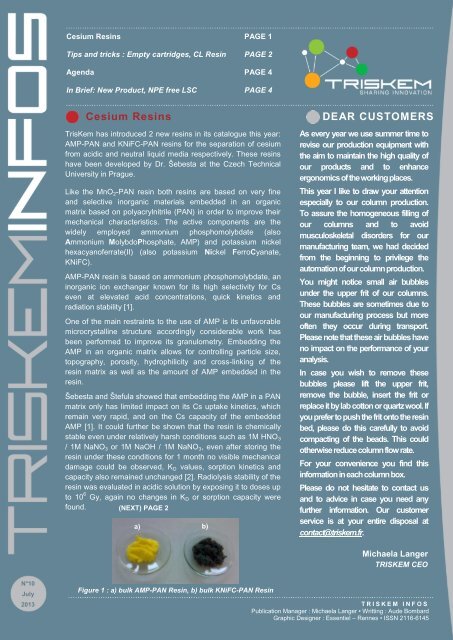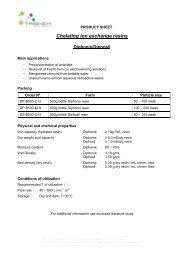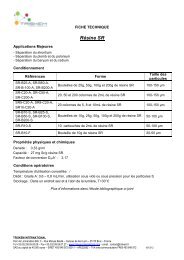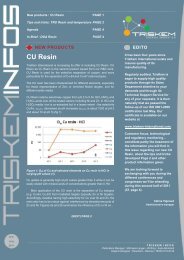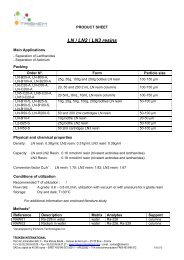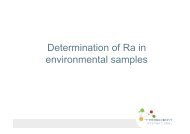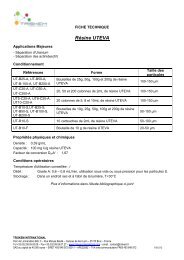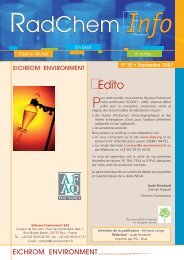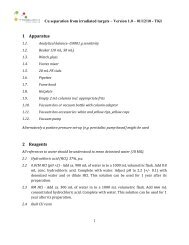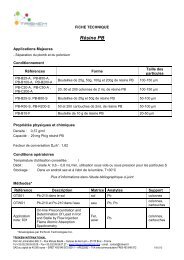Cesium Resins DEAR CUSTOMERS - TrisKem International
Cesium Resins DEAR CUSTOMERS - TrisKem International
Cesium Resins DEAR CUSTOMERS - TrisKem International
Create successful ePaper yourself
Turn your PDF publications into a flip-book with our unique Google optimized e-Paper software.
<strong>Cesium</strong> <strong>Resins</strong> PAGE 1Tips and tricks : Empty cartridges, CL Resin PAGE 2Agenda PAGE 4In Brief: New Product, NPE free LSC PAGE 4<strong>Cesium</strong> <strong>Resins</strong><strong>TrisKem</strong> has introduced 2 new resins in its catalogue this year:AMP-PAN and KNiFC-PAN resins for the separation of cesiumfrom acidic and neutral liquid media respectively. These resinshave been developed by Dr. Šebesta at the Czech TechnicalUniversity in Prague.Like the MnO 2 -PAN resin both resins are based on very fineand selective inorganic materials embedded in an organicmatrix based on polyacrylnitrile (PAN) in order to improve theirmechanical characteristics. The active components are thewidely employed ammonium phosphomolybdate (alsoAmmonium MolybdoPhosphate, AMP) and potassium nickelhexacyanoferrate(II) (also potassium Nickel FerroCyanate,KNiFC).AMP-PAN resin is based on ammonium phosphomolybdate, aninorganic ion exchanger known for its high selectivity for Cseven at elevated acid concentrations, quick kinetics andradiation stability [1].One of the main restraints to the use of AMP is its unfavorablemicrocrystalline structure accordingly considerable work hasbeen performed to improve its granulometry. Embedding theAMP in an organic matrix allows for controlling particle size,topography, porosity, hydrophilicity and cross-linking of theresin matrix as well as the amount of AMP embedded in theresin.Šebesta and Štefula showed that embedding the AMP in a PANmatrix only has limited impact on its Cs uptake kinetics, whichremain very rapid, and on the Cs capacity of the embeddedAMP [1]. It could further be shown that the resin is chemicallystable even under relatively harsh conditions such as 1M HNO 3/ 1M NaNO 3 or 1M NaOH / 1M NaNO 3 , even after storing theresin under these conditions for 1 month no visible mechanicaldamage could be observed, K D values, sorption kinetics andcapacity also remained unchanged [2]. Radiolysis stability of theresin was evaluated in acidic solution by exposing it to doses upto 10 6 Gy, again no changes in K D or sorption capacity werefound. (NEXT) PAGE 2a) b)<strong>DEAR</strong> <strong>CUSTOMERS</strong>As every year we use summer time torevise our production equipment withthe aim to maintain the high quality ofour products and to enhanceergonomics of the working places.This year I like to draw your attentionespecially to our column production.To assure the homogeneous filling ofour columns and to avoidmusculoskeletal disorders for ourmanufacturing team, we had decidedfrom the beginning to privilege theautomation of our column production.You might notice small air bubblesunder the upper frit of our columns.These bubbles are sometimes due toour manufacturing process but moreoften they occur during transport.Please note that these air bubbles haveno impact on the performance of youranalysis.In case you wish to remove thesebubbles please lift the upper frit,remove the bubble, insert the frit orreplace it by lab cotton or quartz wool. Ifyou prefer to push the frit onto the resinbed, please do this carefully to avoidcompacting of the beads. This couldotherwise reduce column flow rate.For your convenience you find thisinformation in each column box.Please do not hesitate to contact usand to advice in case you need anyfurther information. Our customerservice is at your entire disposal atcontact@triskem.fr.Michaela LangerTRISKEM CEON°10July2013Figure 1 : a) bulk AMP-PAN Resin, b) bulk KNiFC-PAN ResinT R I S K E M I N F O SPublication Manager : Michaela Langer • Writting : Aude BombardGraphic Designer : Essentiel – Rennes • ISSN 2116-6145
Tips and Tricks Empty cartridgesWe now propose emptycartridges of 2 and 12mLFigure 3: Empty cartridges of 2mLand 12mL.Desorption of the cesium is only possible using concentrated ammonium salts,10 bed volumes of 5M NH 4 Cl for example elute 92% of Cs from a column [1](alternatively NH 4 NO 3 might be used [3]) or by destruction of the AMP usingstrong alkaline solutions (like 5M NaOH).Its high selectivity for Cs even under harsh chemical conditions and high levelsof radioactivity make the AMP-PAN resin a candidate resin for the treatment ofradioactive waste solutions. Brewer et al. [3] tested the resin for the removal ofCs-137 from real and simulated acidic high-active liquid radioactive wastecontaining high amounts of potassium and sodium. Small scale tests wereperformed using 1.5 mL columns and two feed solutions, one simulated tankwaste (spiked with 100 Bq.mL -1 Cs-137) and one actual tank waste. Bothsolutions were filtered, and pumped through the column using a pump system ata flow rate of 26 – 27 bed volumes per hour, aliquots were taken at regularintervals and analyzed for Cs-137 activity. After the experiment the AMP-PANcolumns were eluted using 30 bed volumes of 5M NH 4 NO 3 , reconditioned andthe effluents were passed over the column a second time. For the real wastesamples a Cs breakthrough of 0.15% was observed after a sample loadingvolume of 1000 bed volumes during the first loading cycle (corresponding to aCs decontamination factor greater than 3000) and 0.53% after 830 bed volumesduring the 2 nd loading cycle. Cs recoveries in the respective eluates were 87%.Tank WastesWash solutionElution solution CL ResinIt is now indicated on the CLResin packagings that the resincomes NOT loaded with Ag+. CLResin is to be activated with Ag+solution prior to use. The CLResin method (TKI_CL01_V14)has been updated accordinglyand is available online.Figure 4: Additional labelling onCL Resin products.<strong>Cesium</strong> fractionBedVolume1.5 mLAliquotes for Cs testing every 3-5h<strong>Cesium</strong> content testingFigure 2: Separation scheme for the separation and determination of cesium inwaste effluent [3].AMP-PANs robustness against high salt concentrations also makes it interestingfor use in environmental analysis, especially the analysis of Cs-134/7 in seawater.Pike et al. [4] used AMP-PAN for concentrating and purifying Cs from 20Lseawater samples (acidified to pH 1 – 2, stable Cs was added for yielddetermination by ICP-MS). The authors employed 5 mL columns and worked ata flow rate of 35 mL.min -1 . After extraction the resin was rinsed from the columnusing 0.1M HNO 3 and analyzed by gamma spectrometry. Yields were found tobe 93.5% +/- 5.0% (n=55). The authors further analyzed an internal lab standard(WHOI) in triplicate and IAEA sea water reference material, results aresummarized in table 1.SamplereferenceReference value/ Bq.m -3 Obtained value/ Bq.m -3WHOI 3.4 +/- 0.4 3.7 +/- 0.2IAEA-443 340 - 370 369 +/- 8Table 1: Results in <strong>Cesium</strong> obtained using reference material on AMP-PAN resin.For more information, do not hesitate to contact us and/or to downloadthe technical data sheets from our website www.triskem-international.comPage 2
Even larger seawater samples were analysed by Kamenik et al. [5]. The authors evaluated, in addition to the AMP-PAN resin, also the use of KNiFC-PAN resin, which is based on potassium-nickel hexacyanoferrate(II) embeddedin a PAN matrix.The authors passed 100L of acidified seawater samples (in case of KNiFC-PAN unacidified seawater sampleswere tested as well) through 25 mL beds of AMP-PAN or KNiFC-PAN resin at flow rates up to 300 mL.min -1allowing for processing 100L samples in less than 6h. As described before stable Cs was added to the seawatersamples to allow for the determination of the chemical yield e.g. via ICP-MS. After loading resins were rinsed fromthe columns, dried and measured by gamma spectrometry using a coaxial HPGe detector with 43% rel. efficiencyin Petri dish geometry. Chemical yields obtained are summarized in table 2. Yields are generally high, KNiFC-PANshowing slightly higher yields for the acidified seawater samples than AMP-PAN resin and comparable chemicalyields for acidified and non-acidified seawater samples.Resin Matrix Chemical yield / %AMP-PAN sea water (pH 1) 88,1 +/- 3,3KNiFC-PAN sea water (pH 1) 92,9 +/- 1,1KNiFC-PAN sea water 90,2 +/- 2,7Table 2: Comparison of obtained chemical yields, 100 L sea water samples, AMP-PAN and KNiFC-PAN [5]Higher flow rates were tested for the processing of non-acidified sea water samples on KNiFC-PAN resin; even at aflow rate of 470 mL.min -1 Cs yield is still greater than 85%.The authors calculated the minimum detectable activity (MDA) for 100L samples at 50 – 70 h counting time andaverage chemical yields. For Cs-137 they calculated an MDA of 0.15 Bq.m -3 and 0.18 Bq.m -3 for Cs-134.KNiFC-PAN resin was further used for the determination of Cs isotopes in milk [6] and urine [7]. Scheme of theprocedure is shown Fig. 5. The chemical yield in Cs was about 95% for both urine and milk. For milk, the MDAobtained was 2mBq.l-1 for 137Cs in 5 liters milk sample (HPGe detector, relative efficiency 140%, counting time600000 s, = 1g.cm -3 ).Milk•Fresh liquid milk (≤ 5l)(for stabilisation of milk:2ml formaldehyde/1l milk)Pre-treatmentUrine• 1-day sample of urine• Acidification (10ml HCl)• Dilution up to 2l w/ H 2 O• KNiFC-PAN (0,4-1,0mm)• Bed resin = 15 ml• Flowrate ≤ 50ml.min -1Concentration• KNiFC-PAN (0,4-0,8mm)• Bed resin = 15 ml• Flowrate ≤ 50ml.min -1• Washing w/ H 2 O• Transfer to counting vial(EtOH) – (Drying)Counting samplepreparation• Washing w/ H 2 O• Transfer to counting vial(EtOH) – (Drying)- spectrometry CountingFigure 5: Separation scheme of Cs in milk and urine samples.Other than for Cs separation AMP based ion exchangers have also been used to separate Rb from other alkalinesin acidic media [8, 9].Page 3For more information contact or visit our websitehttp://www.triskem-international.com/
AG E N D AWe’ll be participating to thefollowing upcoming conferencesand are very much looking forwardto meeting and discussing with youthere!° 8 th LSC Anwendertreffen, 30/09 –01/10/13, Tübingen (Germany)www.unituebingen.de/einrichtungen/zentraleeinrichtungen/isotopenlaborstrahlenschutz/veranstaltungen.html° NKS Workshop on RadioanalyticalChemistry, 02/09 – 06/09/13, Roskilde(Denmark)http://www.nks.org/en/seminars/upcoming_seminars/nks-b_radioanalysis.htm° Asia-Pacific Symposium onRadiochemistry - APSORC 201322/09-27/09/13, Kanazawa (Japan)www.radiochem.org/apsorc13/° Russian-Nordic Symposium onRadiochemistry, 21/10 – 24/10/13,Moscow (Russia), http://rnsr.org/You will find an update on ourparticipations to conferenceson our websitewww.triskem-international.comFigure 6: filtration units usingResolve Filters (Ref RF-DF25-25PP01).Bibliography(1) Sebesta F, Stefula V (1990) Composite ion exchanger with ammoniummolybdophosphate and its properties. J Radioanal Nucl Chem 140(1):15 - 21(2) John et al. (1999) Application of new inorganic-organic composite absorbers withpolyacrilonitril binding matrix for separation of radionuclides from liquidradioactive wastes. Choppin and Khankhasayev (eds.) Chemical separationtechnologies and related methods of nuclear waste management, 155 - 168(3) Brewer et al. (1999) AMP-PAN column tests for the removal of Cs-137 fromactual and simulated INEEL high-activity wastes. Czechoslov J Phys 49(S1):959-964(4) Pike et al.. (2012) Extraction of cesium in seawater off Japan using AMP-PANresin and quantification via gamma spectroscopy and inductively coupled massspectrometry. Radioanal Nucl Chem. DOI 10.1007/s10967-012-2014-5(5) Kamenik et al. (2012) Fast concentration of dissolved forms of cesiumradioisotopes from large seawater samples. J Radioanal Nucl Chem. DOI10.1007/s10967-012-2007-4(6) Kamenik J et al. (2009) Long term monitoring of Cs-137 in foodstuffs in theCzech Republic. Appl Radiat Isot 67(5):974-977(7) Bartuskova et al. (2007) Ingestion doses for a group with higher intake of Cs-137. In: IRPA regional congress for Central and Eastern Europe, Brasov,Romania(8) Coetze CJ : The separation of a sodium-rubidium mixture on an ion exchanger.(1972) J Chem Edu 49(1): 33(9) Smit, J van R, Robb W, Jacobs JJ: Cation exchange on ammoniummolybdophosphate—I: The alkali metals (1959) J Inorg Nucl Chem, 12(1-2): 104-112I n B r i e f :N e w p r o d u c tStarting this summer, we provide/offer a new accessory allowing thepreparation of alpha spectrometry sources via micro-precipitation directly usingthe vacuum box. The filtration funnel units (Ref RF-DF25-25PP01) comepreloaded with our Resolve® filters (see Fig. 6).The funnel units are designed to maximize analyte recovery and the resolutionof the filter. They are also designed with a notch, allowing for easy removal offilters with tweezers for planchet placement.L i q u i d s c i n t i l l a t i o n c o c k t a i l s N P E s f r e eNPE’s and APE’s are widely used as surfactant not only in liquid scintillationcocktails but also in detergent/textile industries/… European Directive2003/53/EC bans the use of NPE’s/APE’s at concentration above 0.1% inthese industries as the leaking of these molecules to the environment hasengendered environmental issues due to high toxicity (endocrinianperturbators) and low biodegradability. Although their use in liquid scintillationcocktails is not restricted by the EU directive, the supply of these reagentsmight become an issue in the next decade. Meridian Biotechnologies Ltd,manufacturer of the LS cocktail product line distributed by <strong>TrisKem</strong>, hasalready moved to a new generation of NPE free LS cocktails with their ProSafeline of scintillation cocktails. For more information do not hesitate to visit ourwebsite or to contact us.We remain at your disposal to study your specific needs.DO NOT HESITATE TO CONTACT US FOR MORE INFORMATION ORTO OBTAIN OUR NEW PRICE LISTTRI S KEM INTERNA TI O N ALParc de Lormandière Bât. C • Rue Maryse Bastié . • Campus de Ker Lann • 35170 Bruz • FRANCETel +33 (0)2.99.05.00.09 • Fax +33 (0)2.99.05.07.27www.triskem-international.com • email : contact@triskem.fr


